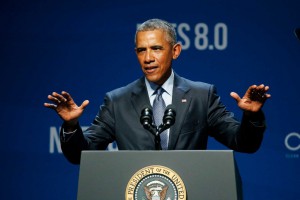US Acts to promote renewable energy and energy efficiency
 GLOBE-Net, August 24, 2015 – U.S. President Barack Obama today announced a series of measures to address climate change, promote clean energy and energy efficiency, and drive innovation.
GLOBE-Net, August 24, 2015 – U.S. President Barack Obama today announced a series of measures to address climate change, promote clean energy and energy efficiency, and drive innovation.
In a speech at a National Clean Energy Summit he announced funding incentives to promote the use and development of low-cost technologies to help households save on their energy bills and to spur the transition to cleaner, and more distributed energy resources.
These include:
- Making $1 billion in additional loan guarantee authority available and announcing new guidelines for distributed energy projects utilizing innovative technology and states looking to access this financing;
- Unlocking residential Property-Assessed Clean Energy (PACE) financing for single-family housing to make is easier for Americans to invest in clean energy technologies;
- Launching a new program to provide home owners with a simple way to measure and improve the energy efficiency of their homes, by increasing homeowners borrowing power;
- Creating a DOD Privatized Housing Solar Challenge, and announcing companies are committing to provide solar power to housing on over 40 military bases across the United States;
- Announcing $24 million for 11 projects in seven states to develop innovative solar technologies that double the amount of energy each solar panel can produce from the sun;
- Approving a transmission line that will support bringing online a 485-megawatt photovoltaic facility that will be constructed in Riverside County California and produce enough renewable energy to power more than 145,000 homes;
- Creating an Interagency Task Force to Promote a Clean Energy Future for All Americans; and
- Announcing independent commitments from local governments, utilities, and businesses that are stepping up to drive energy efficiency in more than 300,000 low-income households and investing more than $220 million in energy saving activities for veterans and low-income customers to help decrease their energy bills.
Household Solar Incentives

Man installing alternative energy photovoltaic solar panels on roof
Perhaps the most significant measures announced today involve a massive infusion of funding for the deployment of solar energy for homeowners.
Both the White House and Federal Housing Administration (FHA) released statements indicating that they are preparing new Property Assessed Clean Energy (PACE) guidance designed to “remove existing barriers and accelerate the use of PACE financing for single family housing.”
PACE allows property owners to voluntarily finance the entire cost of energy efficiency, water efficiency, and renewable energy upgrades to their homes and businesses and then repay those costs as a line item on their property tax bill.
The FHA, which insures over 20% of new mortgage originations in the United States, outlined a set of principles associated with their new guidance – including allowing PACE financing to transfer between owners during the sale of the home if the PACE lien can be subordinated during a foreclosure; those guidelines are available here.
States and State Green Banks encouraged
Today’s announcement includes guidance from the Department on how a Distributed Energy Project transaction could be properly structured to receive funding support and a clarification of how state-affiliated financial entities, including state green banks, may submit applications for Eligible Projects.
That means any state or state-affiliated entity that satisfies all other requirements for qualification as a borrower can submit applications for Eligible Projects, including Distributed Energy Projects. In addition, the Department made clear today that state and state-affiliated entities, including state green banks, may participate in Distributed Energy Projects as lenders or co-lenders, off-takers or equity providers.
The additional funding for distributed energy projects utilizing innovative technologies will accelerate the transformation of U.S. energy markets already underway from the growing deployment of rooftop solar technologies, new energy storage systems, smart grid technologies, and methane capture for oil and gas wells.
US Climate Goals
The United States has set an economy-wide target to reduce emissions by 26%-28% below 2005 levels in 2025 and to Increase the share of renewables – beyond hydropower – in their respective electricity generation mixes to the level of 20% by 2030.
It has also targeted the installation of 300 megawatts of renewable energy across federally subsidized housing by 2020; and doubling energy productivity by 2030.
See here for more information on the various measures that were announced today.



